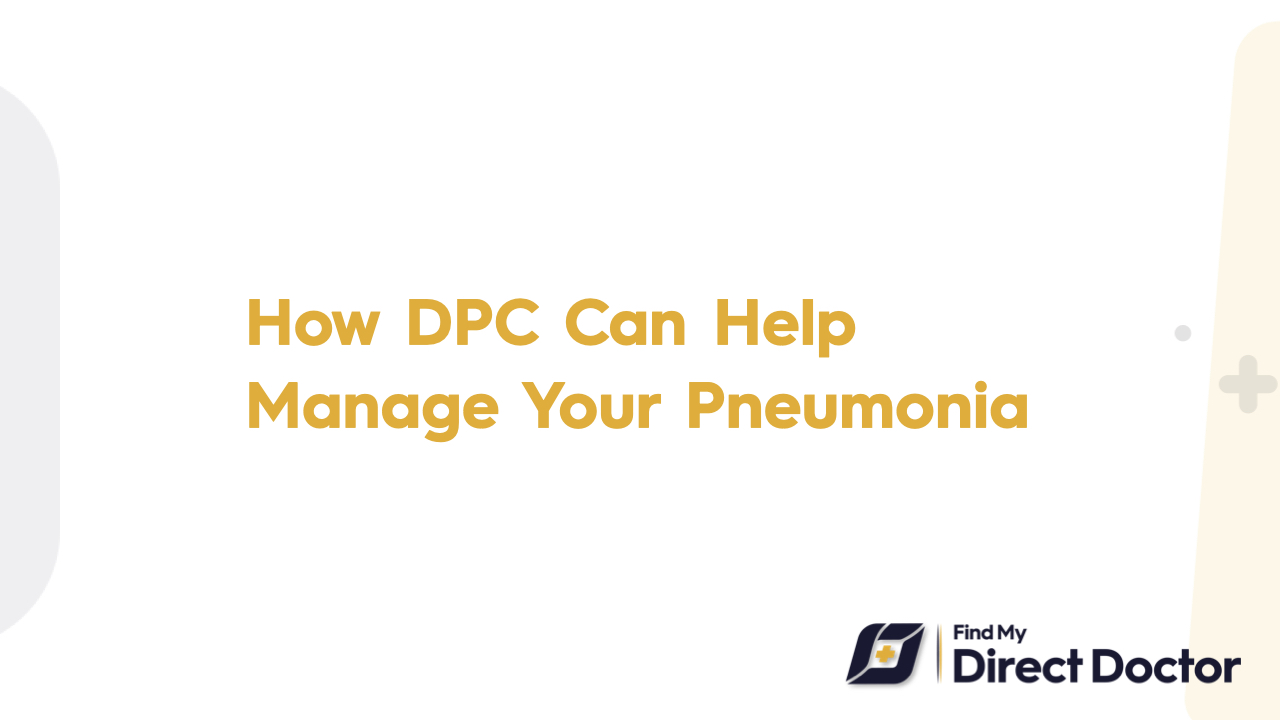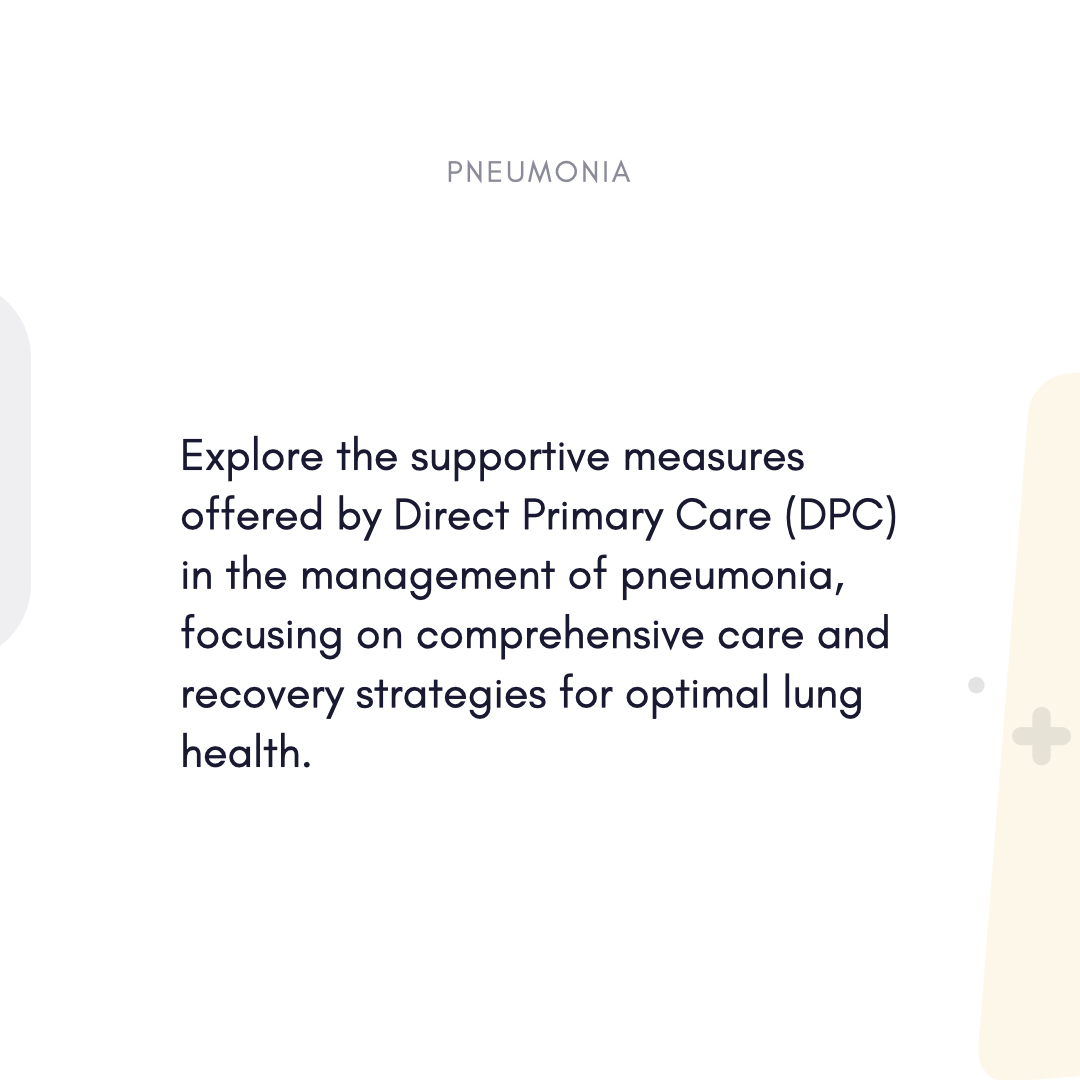Pneumonia and Direct Primary Care (DPC): Rapid Recovery with Personalized, Affordable Care
A deep, persistent rattling cough that won't go away. Chills from fever that cause shaking. This lung infection is the main cause of severe illness among the 1 million+ Americans hospitalized with pneumonia yearly. Though there is hope: Direct Primary Care (DPC) provides quick, thorough treatment to eradicate pneumonia and prevent complications, traditional care usually means ER waits and scattered follow-ups.

Realizing Pneumonia
An infection invading one or both lungs, pneumonia causes inflammation of the air sacs. There are causes like:
- Bacteria, for example Streptococcus pneumoniae
- Viruses, including COVID-19, RSV, and influenza
- Fungi (rare, in patients with immunocompromision)
Symptoms comprise:
- Productive coughing (yellow/green mucus)
- Fever, perspiration, dyspnea
- Chest discomfort during breathing
The dangers of untreated pneumonia:
- Sepsis or respiratory trouble
- Pleural effusion or abscesses of the lungs
- Hospitalisation, particularly in immunocompromised elderly people
Early antibiotic treatment for bacterial infections is emphasized by the American Thoracic Society as means of lowering mortality.
DPC Changes: Pneumonia Treatment: Care
Operating on a membership model usually 50 USD–150 USD/month, Direct Primary Care (DPC) provides unlimited access to your physician for a set fee. For those with pneumonia, this translates into no ER delays, no co-pays, and a treatment plan as strong as your lungs.
1. Quick diagnosis and treatment
The easily available DPC model guarantees:
- Same-day coughing or fever evaluations.
- Testing in-office: pulse oximetry, chest X-rays, fast flu/COVID tests.
- For bacterial cases, amoxicillin-clavulanate is the immediate antibiotic; oseltamivir is the antiviral agent.
2. Customized, Evidence-Based Treatment
DPC doctors design customized plans compliant with IDSA/ATS recommendations:
- Based on risk factors, macrolides or respiratory fluoroquinolones treat bacterial pneumonia.
- Supportive treatment (hydration, rest) plus monoclonal antibodies for high-risk COVID-19 pneumonia.
- High-risk patients should be early referred for oxygen therapy or IV antibiotics.
3. All-encompassing, reasonably priced assistance
DPC lowers health and financial risk by:
- Cutting medicine costs: Wholesale price for inhalers or antibiotics.
- Telehealth access available 24/7: tracking oxygen levels or controlling rebound fevers.
- Vaccines against pneumococcal and flu will help to prevent recurrence.
DPC's advantages for pneumonia sufferers
1. Unequal accessibility
- 24/7 access for a provider during nighttime coughing fits or breathing difficulties.
- No wait for specialist referrals or chest X-rays.
2. Individualized Interventions
- Managing comorbidity means changing antibiotics for penicillin allergies or kidney disease.
- Pulse oximeters, hydration packs, and cough suppressors make up home recovery kits.
3. Open Cost Transparency
- Membership covers consultations, basic imaging, and follow-ups—no hidden fees.
- Typical savings of 3,000 USD+ by cutting ER visits and pointless hospital stays.
Personal Success Stories from Real Life
- Case 1: Developing bacterial pneumonia, 68-year-old Sarah has COPD. Her DPC physician ordered levofloxacin, set up home oxygen, and conducted daily telehealth checks. She steered clear of being hospitalized.
- Case 2: COVID pneumonia struck 45-year-old Tom. His DPC provider taught prone positioning, prescribed sotrovimab, and tracked with pulse ox. He got well right at home.
Ask questions about DPC and pneumonia.
- Q: Can DPC manage severe pneumonia calling for hospitalisation?
- A: Exactly. Direct admissions are coordinated by DPC doctors; they also guarantee flawless post-discharge treatment and secure cash-pay rates.
- Q: For uninsured patients, is DPC reasonably priced?
- A: Certainly. Members avoid 1,500 USD+ ER costs and save 50–70% on drugs.
- Q: What should I do if I need a pulmonologist?
- A: A DPC doctor negotiates self-pay discounts and speeds consults by working with lung experts.
Why DPC Is a Win for Pneumonia Patients
Emphasizing DPC's following of pneumonia guidelines, the American Academy of Family Physicians supports:
- Speed: Early antibiotics inside the "golden window" to avoid complications.
- Precision: From empirical broad-spectrum overtreatment to culture-guided therapy.
- Tools to monitor home oxygen levels and symptoms help to empower you.
Recover Faster and Breathe Easier
Pneumonia doesn't have to knock you down for several weeks. One breath at a time, DPC helps you to find a partner who acts quickly, treats precisely, and walks with you back to complete health.






